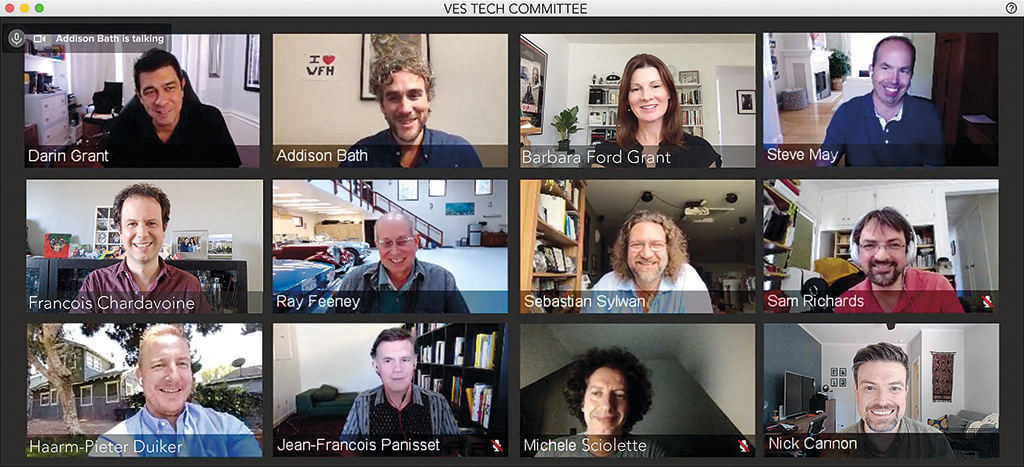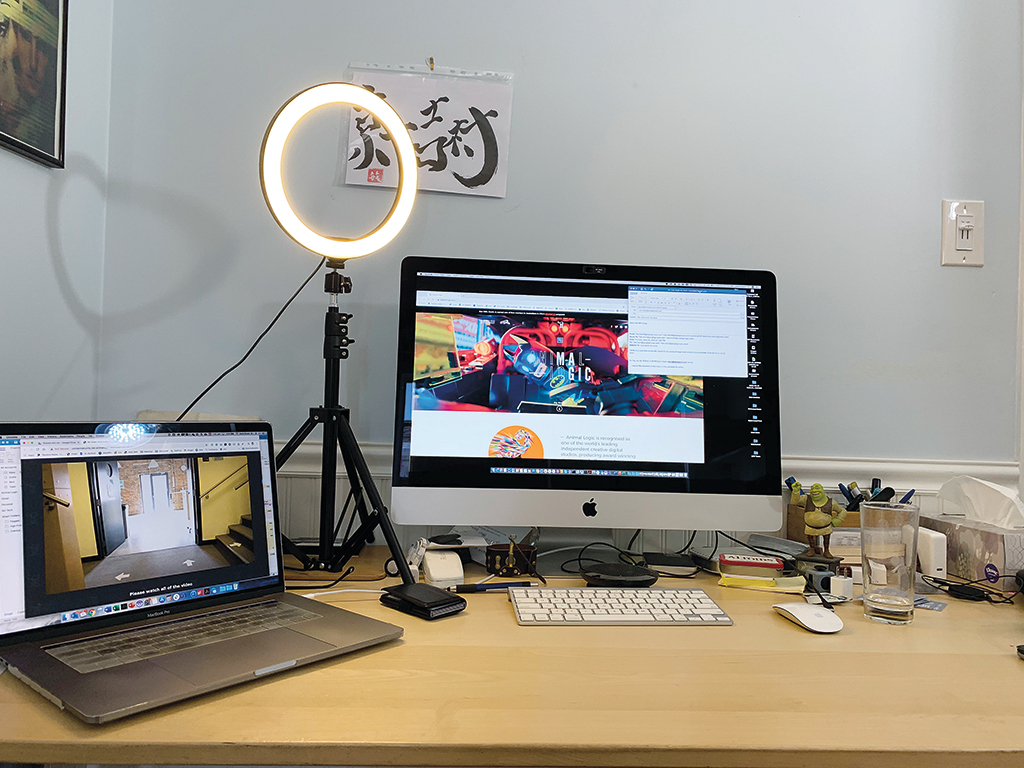By THE VES TECHNOLOGY COMMITTEE
By THE VES TECHNOLOGY COMMITTEE
This year our industry faced an unprecedented health crisis that presented challenges to our safety, technology and security. Many of our members’ businesses and employers were forced to take radical action. The VES responded by helping encourage a dialogue between members, studios, vendors and facilities to move us all forward. One of the groups leading the effort was the VES Technology Committee. The committee is composed of professionals from across the industry that represent a diverse set of technical backgrounds and works with other industry organizations like the Academy Software Foundation to develop and promote common standards and best practices across the industry.
Recent projects led by the committee include the VFX Reference Platform, Cinematic Color Pipeline and Camera Report specification. Acting as a technical conduit to software vendors and helping push initiatives to benefit the VFX industry as a whole are also part of our core mission.
In response to the COVID-19 pandemic, the VES Technology Committee began meeting on a weekly basis to share ideas and give updates on successful attempts to start solving the engineering problems presented by Working From Home (WFH) during the pandemic. The lockdown of non-essential commercial activity came swiftly in the areas where VFX facilities are clustered. Most facilities only had a few days to set up initial WFH infrastructure before the lockdowns became effective. These weekly committee meetings created a platform to develop a document for best practices that was shared across the industry and is open to anyone who wishes to contribute additional ideas. The document (available at: https://tinyurl.com/VES-Covid19) continues to evolve and represents an excellent reference point to develop WFH procedures and strategy. Additional resources for working remotely can be accessed on the VES website at: https://www.visualeffectssociety.com/ves-covid-19-resources/.

The majority of VFX work requires on-premises infrastructure for some combination of security, technical and economic reasons. Few companies in our industry had plans in place to meet the challenge of a global pandemic under these constraints. The wholesale conversion of facilities to a WFH scenario was not something that was previously considered, given the physical security requirements necessary to ensure the safety of intellectual property. As an industry, we needed to think quickly, adapt our methods, and invent new procedures to continue our creative journey. The main solution to tackle the challenge involved extending the desktop workstation experience to the user’s home. This required remote display solutions, so that no actual production files needed to leave the facilities’ networks. This solution transfers the display of secure office workstations directly to home computer screens over an encrypted data stream.
Some facilities were already leveraging these remote access solutions internally in order to gain flexibility in electrical requirements, improve cooling, reduce the physical labor of moving heavy workstations around the facility, and manage the requirements for physically secure locations for end users. Others were using this technology to support a hybrid model where some users worked remotely. For these facilities already using remote display solutions, the most straightforward approach was to extend this infrastructure to allow everyone to work remotely. Thus infrastructure initially deployed to meet on-premises flexibility goals turned out to be a crucial part of a disaster mitigation plan.
Owners and managers of facilities without existing infrastructure had to quickly decide on a solution they could deploy in a very short time. This meant assessing technologies the in-house teams were already familiar with and exploring what expertise and services were offered by industry-specific resellers, consultants and system integrators. The animation and VFX technology community came together on various forums to share as much expertise as possible. This helped avoid duplication of effort at the start of the crisis and quickly spread information focused on remote access technologies. The industry also needed to seek software-based solutions since supply chains had already been impacted. Licensing models and costs of commercial solutions needed to fit within the technical, operating, and business plan of each company. In addition, some other facilities preferred to leverage capabilities already included in client operating systems or to use free or open-source technologies.

The workflows for VFX and animation also created unique challenges. Many users required higher resolution, frame rate, and/or more color accuracy than typical remote office work. Remote access protocols specifically targeting the media and entertainment industries typically have better support for these requirements. VFX facilities often use a mix of Windows, Linux and Mac systems. Users were often required to use their personal equipment at home to access their workstation back at the office (and in some cases, mobile devices running iOS/Android were part of the equation). At the time, few remote access solutions supported all of these platforms on both the server-side (the workstation at the office) and the client-side (the device used at home). So, in many cases, more than one remote access system had to be deployed to efficiently support different platforms required for different workflows.
Additional challenges were presented by latency and bandwidth of home internet connections. Any extra delay directly affects tasks that are dependent on getting immediate feedback from interacting with your mouse or tablet, such as storyboarding, production design, modeling and texture painting. This remains a challenge today, especially as not all combinations of operating systems and remote display technology are compatible with input accessories like tablets. The Tech Committee worked to voice these issues to software and hardware vendors and has seen responses in the form of fixes, new releases and planned improvements. More than anything, though, it has become clear there is not an industry-standard alternative to artists sitting together in a calibrated room, viewing and discussing high-resolution and high-dynamic-range uncompressed color-correct content in real-time. Most teams cobbled together workflows by combining commodity video-conferencing software solutions. Reviewers were forced to accept imperfect synchronized playback or approaches that required pre-staging media on every user’s work-provided device, adding delay to the creative approval process. A few cloud and streaming solutions are beginning to emerge, but they are not yet fully vetted from a security point of view. This is an area that will likely see significant evolution over time.
Digital content security is incredibly important to everyone, from client studios to VFX and animation facilities, with strict and precise requirements that are often mandated in order to work on certain projects. Facilities doing this work were compelled to coordinate with the security teams of the content owners to ensure that the remote-access infrastructure met enough security requirements and best practices. Previously, this involved a strict separation between machines accessing pre-release content and the open internet. The necessity of remote work required a significant departure from these security postures that barred any access to content from employees’ homes. A common approach to address this was to leverage VPN technology, which encrypts all traffic between a user and their company’s datacenter. Since allowing production content to be broadly accessed by employees from home wasn’t a typically permissible working condition in most facilities, no standardization existed around these requirements. It was only after several iterations that facilities derived a practical checklist to which employees were asked to adhere. Helping users walk through the huge variety of home setups and troubleshooting the problems that users encountered was a challenge for already strained IT departments. Home users, in many cases, were required to upgrade the security of their Wi-Fi by reconfiguring their router. Additional security requirements included a minimum precaution that all monitors face away from doors and windows in order to minimize exposure to additional family members. There was another potential challenge for those who share their home space with individuals employed at other facilities.
While pre-existing workflows have undoubtedly been impacted by the aforementioned challenges, new opportunities and workflows have evolved to allow productivity to continue at levels close to those from before the disruption. Reports started flowing in about the advantages of checking a render after dinner, managing time more flexibly, and not having to wait for a meeting room when a client review runs long. The collaboration through video conferencing was forced on the industry, but some of the workflow changes are viewed as positive.

Having made the leap to allow Working From Home, studios and VFX partners are recognizing this as a time to completely reimagine workflows. There is an expectation that WFH and distributed collaboration will be the new norm for at least a portion of the workforce. We are learning what safety looks like in a post-COVID-19 world. Potential benefits of artists working remotely include rapid scaling of resources based on current needs and easing the need for costly infrastructure build-outs. It’s a great time for experimentation and rethinking the way we work, including an evaluation of cloud solutions that might enable more elastic resources to leverage the global ecosystem.
While visual effects is a highly competitive sector of content creation, the community recognizes we must come together for the health and safety of our talent and clients. New protocols will lead to shorter shooting days and longer shooting schedules. There will be more extensive visual effects and a need for digi-doubles where extras once stood. Producers will need to carefully evaluate what can happen remotely versus what can be achieved in post-production. Previsualization will likely become an even more helpful tool to plan and execute shoots efficiently and safely. Methods of virtual production may offer the potential for a reduced footprint, but will not be able to replace top talent or fully address the needs of collaborative filmmaking. Remote-friendly collaborative tools that familiarize, simplify or abstract the more technical parts of the creative process and allow artists to focus on vision will be in high demand.
The weekly meeting [of the VES Technology Committee] created a platform to develop a document for best practices that was shared across the industry and is open to anyone who wishes to contribute additional ideas. The document (available at: https://tinyurl.com/VES-Covid19) continues to evolve and represents an excellent reference point to develop WFH procedures and strategy.

The necessity of remote work required a significant departure from these security postures that barred any access to content from employees’ homes. A common approach to address this was to leverage VPN technology, which encrypts all traffic between a user and their company’s datacenter.
One positive side effect of the crisis for our industry is that content consumption grew. As everyone stayed safe at home, they increasingly wanted new things to watch and play. Streaming service adoption accelerated, which continues to help drive more content creation demand. New platforms including AR and VR are emerging that will require even more services from our industry. Many video games set new sales records as gamers used online services to stay connected with friends and fill more free time. With a very bright future ahead, how do we apply the learnings from this experience and evolve? How do we hold on to the benefits we gained in the COVID-19 response?
As an industry, the WFH transformation has accelerated new approaches to secure remote workflows, but there is more work to be done, and more opportunities to be discovered. It is the opinion of the VES Tech Committee that industry practices would benefit from a more formal exchange of ideas and a broader discussion of lessons learned. We would like to advocate that the industry choose a method to foster dialogue and create permanent change, perhaps utilizing some form of an ongoing working group to build upon the efforts that have taken place.
Many thanks are owed to the very small group of dedicated individuals who helped capture the information, prepare the document and coordinate the efforts of the VES Tech Committee. This greatly helped with the emergency transition that occurred, but going forward we see a place for a broader industry focus on best practices with more voices participating.